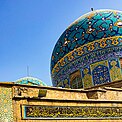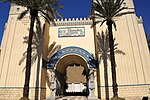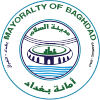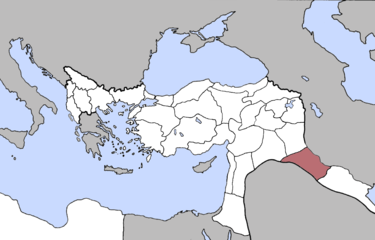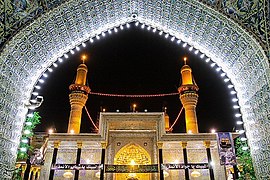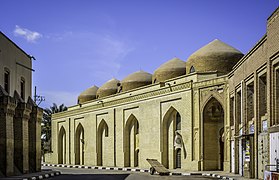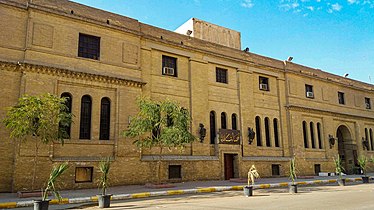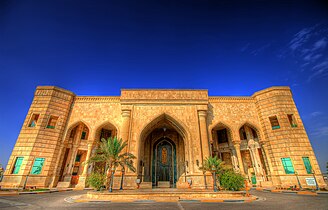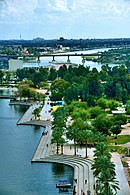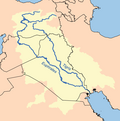|
Baghdad
Baghdad[note 1] (Arabic: بغداد, Baghdād) is the capital and largest city of Iraq, located along the Tigris in the central part of the country. With a population exceeding 7 million, it ranks among the most populous cities in the Middle East and Arab World and forms 22% of the country's population. Spanning an area of approximately 673 square kilometres (260 sq mi), Baghdad is the capital of the Baghdad Governorate and serves as Iraq's political, economic, and cultural hub. Founded in 762 AD by Al-Mansur, Baghdad was the capital of the Abbasid Caliphate and became its most notable development project. The city evolved into a cultural and intellectual center of the Muslim world. This, in addition to housing several key academic institutions, including the House of Wisdom, as well as a multi-ethnic and multi-religious environment, garnered it a worldwide reputation as the "Center of Learning". For much of the Abbasid era, during the Islamic Golden Age, Baghdad was one of the largest cities in the world (rivals Chang'an), as the population peaked at more than one million. It was largely destroyed at the hands of the Mongol Empire in 1258, resulting in a decline that would linger through many centuries due to frequent plagues and multiple successive empires. The city was part of the Ottoman Empire's Baghdad Vilayet until World War I, when it was captured by British forces. Baghdad became the capital of the former British Mandate of Mesopotamia in 1921. With the recognition of Iraq as an independent monarchy in 1932, it gradually regained some of its former prominence as a significant center of Arab culture. During the oil boom in Iraq, the city experienced a period of prosperity and growth. It faced severe infrastructural damage due to the Iraq War, which began with the 2003 invasion of Iraq, resulting in a substantial loss of cultural heritage and historical artifacts. Impacted by the subsequent insurgency and renewed war, during this period, it had one of the highest rates of terrorist attacks in the world. However, terrorist attacks have gradually been on the decline since the territorial defeat of the Islamic State militant group in Iraq in 2017, and are very rare now. As capital of Iraq, Baghdad is location of the seat of government, national institutions and government ministries and serves as headquarters to numerous companies. It generates 40% of Iraq's GDP. A major center of Islamic history, it is home to numerous historic mosques, as well as a large number of churches, mandis and synagogues, highlighting the city's historical diversity. Baghdad is home to Mustansiriya University, one of the oldest universities and Masjid al-Kādhimayn is visited every year by millions of Shi'ite pilgrims. The city is home to important cultural sites such as the National Museum of Iraq, the Iraqi National Library and the National Media Center. It is also known as the "City of Palaces", as it is home to well known palaces. NameThe name Baghdad is pre-Islamic, and its origin is disputed.[3] The site where the city of Baghdad developed has been populated for millennia. Archaeological evidence shows that the site of Baghdad was occupied by various peoples long before the Arab conquest of Mesopotamia in 637 CE, and several ancient empires had capitals located in the surrounding area.[4] Arab authors, realizing the pre-Islamic origins of Baghdad's name, generally looked for its roots in Middle Persian.[3] They suggested various meanings, the most common of which was "bestowed by God".[3][5] Modern scholars generally tend to favor this etymology,[3] which views the word as a Persian compound of bagh ( Other authors have suggested older origins for the name, in particular the name Bagdadu or Hudadu that existed in Old Babylonian (spelled with a sign that can represent both bag and hu), and the Jewish Babylonian Aramaic name of a place called Baghdatha (בגדתא).[3][13][14] Some scholars suggested Aramaic derivations.[3] Another view, suggested by Christophe Wall-Romana, is that name of "Baghdad" is derived from "Akkad", as the cuneiform logogram for Akkad (𒀀𒂵𒉈𒆠) is pronounced "a-ga-dèKI" ("Agade") and its resemblance to "Baghdad" is compelling.[15][16] When the Abbasid caliph al-Mansur founded a completely new city for his capital, he chose the name "City of peace(Arabic: مدینة السلام, romanized: Madīnat as-Salām),which now refers to the Round City of Baghdad proper. Another explanation is that the Sorani Kurdish language words of (باخ)(bagh) means "the garden of" and (داد)(dad) which stands for "Justice", This was the official name on coins, weights, and other official usage, although the common people continued to use the old name.[17][18][unreliable source?] By the 11th century, Baghdad became almost the exclusive name for the world-renowned metropolis. Christophe Wall-Romana has suggested that al-Mansur's choice to found his "new city" at Baghdad because of its strategic location was the same criteria which influenced Sargon's choice to found the original city of Akkad in the exact same location.[19][20] HistoryFoundation After the fall of the Umayyads, the first Muslim dynasty, the victorious Abbasid rulers wanted their own capital from which they could rule. They chose a site north of the Sassanid capital of Ctesiphon, and on 30 July 762[21] the caliph Al-Mansur commissioned the construction of the city. It was built under the guidance of the Iranian Barmakids.[22] Mansur believed that Baghdad was the perfect city to be the capital of the Islamic Empire under the Abbasids. The Muslim historian al-Tabari reported an ancient prediction by Christian monks that a lord named Miklas would one day build a spectacular city around the area of Baghdad. When al-Mansur heard the story, he became very joyful, for legend has it, he was called Miklas as a child.[23] Mansur loved the site so much he is quoted saying: "This is indeed the city that I am to found, where I am to live, and where my descendants will reign afterward".[24]  The city's growth was helped by its excellent location, based on at least two factors: it had control over strategic and trading routes along the Tigris, and it had an abundance of water in a dry climate. Water exists on both the north and south ends of the city, allowing all households to have a plentiful supply, which was quite uncommon during this time. The city of Baghdad quickly became so large that it had to be divided into three judicial districts: Madinat al-Mansur (the Round City), al-Sharqiyya (al-Karkh) and Askar al-Mahdi (on the West Bank).[25] Al-Mansur also planned out al-Karkh district so that he could separate the markets from the Round City in order to keep the turbulent populace away from the Round City to ensure that the gates would not be open at night for markets. Over time, the markets became diverse and a home to merchants and craftsmen. Officials with the title of "Muhtasib" were hired to look after markets to prevent cheating and check the weighs and measures of stocks.[26] Baghdad eclipsed Ctesiphon, the capital of the Sassanians, which was located some 30 km (19 mi) to the southeast. Today, all that remains of Ctesiphon is the shrine town of Salman Pak, just to the south of Greater Baghdad which is where Salman the Persian is believed to have been buried. Ctesiphon itself had replaced and absorbed Seleucia, the first capital of the Seleucid Empire, which had earlier replaced the city of Babylon. 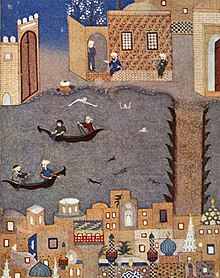 According to the traveler Ibn Battuta, Baghdad was one of the largest cities,[clarification needed] not including the damage it has received. The residents are mostly Hanbalis. Baghdad is also home to the grave of Abu Hanifa where there is a cell and a mosque above it. The Sultan of Baghdad, Abu Said Bahadur Khan, was a Tatar king who embraced Islam.[27] In its early years, the city was known as a deliberate reminder of an expression in the Qur'an, when it refers to Paradise.[28] It took four years to build (764–768). Mansur assembled engineers, surveyors, and art constructionists from around the world to come together and draw up plans for the city. Over 100,000 construction workers came to survey the plans; many were distributed salaries to start the building of the city.[29] July was chosen as the starting time because two astrologers, Naubakht Ahvazi, an Iranian Zoroastrian, and Mashallah, an Iranian Jew, believed that the city should be built under the sign of the lion, Leo.[30] Leo is associated with fire and symbolizes productivity, pride, and expansion and Leo's connection symbolically to Mithra.[citation needed] The bricks used to make the city were 18 in (460 mm) on all four sides. Abu Hanifah was the counter [clarification needed] of the bricks and he developed a canal, which brought water to the work site for both human consumption and the manufacture of the bricks. Marble was also used to make buildings throughout the city, and marble steps led down to the river's edge.[citation needed]   The basic framework of the city consists of two large semicircles about 19 km (12 mi) in diameter. The inner city connecting them was designed as a circle about 2 km (1.2 mi) in diameter, leading it to be known as the "Round City". The original design shows a single ring of residential and commercial structures along the inside of the city walls, but the final construction added another ring inside the first.[31] Within the city there were many parks, gardens, villas, and promenades.[32] There was a large sanitation department, many fountains and public baths, and unlike contemporary European cities at the time, streets were frequently washed free of debris and trash.[33] In fact, by the time of Harun al-Rashid, Baghdad had a few thousand hammams. These baths increased public hygiene and served as a way for the religious to perform ablutions as prescribed by Islam. Moreover, entry fees were usually so low that almost everyone could afford them.[34] In the center of the city lay the mosque, as well as headquarters for guards. The purpose or use of the remaining space in the center is unknown. The circular design of the city was a direct reflection of the traditional Near Eastern urban design. The Sasanian city of Gur in Fars, built 500 years before Baghdad, is nearly identical in its general circular design, radiating avenues, and the government buildings and temples at the center of the city. Much earlier, circular cities had existed in the Syro-Mesopotamian heartland, one of the better-known examples being Mari, while Tell Chuera and Tell al-Rawda also provide examples of this type of urban planning existing in Bronze Age Syria. This style of urban planning contrasted with Ancient Greek and Roman urban planning, in which cities are designed as squares or rectangles with streets intersecting each other at right angles. Baghdad was a hectic city during the day and had many attractions at night. There were cabarets and taverns, halls for backgammon and chess, live plays, concerts, and acrobats. On street corners, storytellers engaged crowds with tales such as those later told in Arabian Nights.[34] Storytelling became a profession called "al-Qaskhun" which survived until the modern era.[35]  The four surrounding walls of Baghdad were named Kufa, Basra, Khurasan, and Syria; named because their gates pointed in the directions of these destinations. The distance between these gates was a little less than 2.4 km (1.5 mi). Each gate had double doors that were made of iron; the doors were so heavy it took several men to open and close them. The wall itself was about 44 m thick at the base and about 12 m thick at the top. Also, the wall was 30 m high, which included merlons, a solid part of an embattled parapet usually pierced by embrasures. This wall was surrounded by another wall with a thickness of 50 m. The second wall had towers and rounded merlons, which surrounded the towers. This outer wall was protected by a solid glacis, which is made out of bricks and quicklime. Beyond the outer wall was a water-filled moat.[citation needed] The Golden Gate Palace, the residence of the caliph and his family, was in the heart of Baghdad, in the central square. In the central part of the building, there was a green dome that was 48m high. Surrounding the palace was an esplanade, a waterside building, in which only the caliph could come riding on horseback. In addition, the palace was near other mansions and officer's residences. Near the Gate of Syria, a building served as the home for the guards. It was made of brick and marble. The palace governor lived in the latter part of the building and the commander of the guards in the front. In 813, after the death of caliph Al-Amin, the palace was no longer used as the home for the caliph and his family.[36] The roundness points to the fact that it was based on Arabic script.[37][38] The two designers who were hired by Al-Mansur to plan the city's design were Naubakht, a Zoroastrian who also determined that the date of the foundation of the city would be astrologically auspicious, and Mashallah, a Jew from Khorasan, Iran.[39] Center of learning (8th–9th centuries)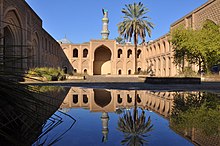 Within a generation of its founding, Baghdad became a hub of learning and commerce. The city flourished into an unrivaled intellectual center of science, medicine, philosophy, and education, especially with the Abbasid translation movement began under the second caliph Al-Mansur and thrived under the seventh caliph Al-Ma'mun.[40] Baytul-Hikmah or the "House of Wisdom" was among the most well known academies,[41] and had the largest selection of books in the world by the middle of the 9th century.[citation needed] Notable scholars based in Baghdad during this time include translator Hunayn ibn Ishaq, mathematician al-Khwarizmi, and philosopher Al-Kindi.[41] Although Arabic was used as the international language of science, the scholarship involved not only Arabs, but also Persians, Syriacs,[42] Nestorians, Jews, Arab Christians,[43][44] and people from other ethnic and religious groups native to the region.[45][46][47][48] These are considered among the fundamental elements that contributed to the flourishing of scholarship in the Medieval Islamic world.[49][50][51] Baghdad was also a significant center of Islamic religious learning, with Al-Jahiz contributing to the formation of Mu'tazili theology, as well as Al-Tabari culminating in the scholarship on the Quranic exegesis.[40] Baghdad is likely to have been the largest city in the world from shortly after its foundation until the 930s, when it tied with Córdoba.[52] Several estimates suggest that the city contained over a million inhabitants at its peak.[53] Many of the One Thousand and One Nights tales, widely known as the Arabian Nights, are set in Baghdad during this period. It would surpass even Constantinople in prosperity and size.[54]  Among the notable features of Baghdad during this period were its exceptional libraries. Many of the Abbasid caliphs were patrons of learning and enjoyed collecting both ancient and contemporary literature. Although some of the princes of the previous Umayyad dynasty had begun to gather and translate Greek scientific literature, the Abbasids were the first to foster Greek learning on a large scale. Many of these libraries were private collections intended only for the use of the owners and their immediate friends, but the libraries of the caliphs and other officials soon took on a public or a semi-public character.[55] Four great libraries were established in Baghdad during this period. The earliest was that of the famous Al-Ma'mun, who was caliph from 813 to 833. Another was established by Sabur ibn Ardashir in 991 or 993 for the literary men and scholars who frequented his academy.[55] This second library was plundered and burned by the Seljuks only seventy years after it was established. This was a good example of the sort of library built up out of the needs and interests of a literary society.[55] The last two were examples of madrasa or theological college libraries. The Nezamiyeh was founded by the Persian Nizam al-Mulk, who was vizier of two early Seljuk sultans.[55] It continued to operate even after the coming of the Mongols in 1258. The Mustansiriyah madrasa, which owned an exceedingly rich library, was founded by Al-Mustansir, the second last Abbasid caliph, who died in 1242.[55] This would prove to be the last great library built by the caliphs of Baghdad. Stagnation and invasions (10th–16th centuries)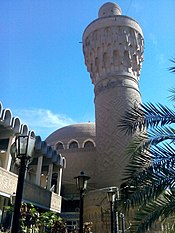  By the 10th century, the city's population was between 1.2 million[56] and 2 million.[57] Baghdad's early meteoric growth eventually slowed due to troubles within the Caliphate, including relocations of the capital to Samarra (during 808–819 and 836–892), the loss of the western and easternmost provinces, and periods of political domination by the Iranian Buwayhids (945–1055) and Seljuk Turks (1055–1135). The Seljuks were a clan of the Oghuz Turks from Central Asia that converted to the Sunni branch of Islam. In 1040, they destroyed the Ghaznavids, taking over their land and in 1055, Tughril Beg, the leader of the Seljuks, took over Baghdad. The Seljuks expelled the Buyid dynasty of Shiites that had ruled for some time and took over power and control of Baghdad. They ruled as Sultans in the name of the Abbasid caliphs (they saw themselves as being part of the Abbasid regime). Tughril Beg saw himself as the protector of the Abbasid Caliphs.[58] Baghdad was captured in 1394, 1534, 1623 and 1638. The city has been sieged in 812, 865, 946, 1157, 1258 and in 1393 and 1401, by Tamerlane. In 1058, Baghdad was captured by the Fatimids under the Turkish general Abu'l-Ḥārith Arslān al-Basasiri, an adherent of the Ismailis along with the 'Uqaylid Quraysh.[59] Not long before the arrival of the Saljuqs in Baghdad, al-Basasiri petitioned to the Fatimid Imam-Caliph al-Mustansir to support him in conquering Baghdad on the Ismaili Imam's behalf. It has recently come to light that the famed Fatimid da'i, al-Mu'ayyad al-Shirazi, had a direct role in supporting al-Basasiri and helped the general to succeed in taking Mawṣil, Wāsit and Kufa. Soon after,[60] by December 1058, a Shi'i adhān (call to prayer) was implemented in Baghdad and a khutbah (sermon) was delivered in the name of the Fatimid Imam-Caliph.[60] Despite his Shi'i inclinations, Al-Basasiri received support from Sunnis and Shi'is alike, for whom opposition to the Saljuq power was a common factor.[61]  On 10 February 1258, Baghdad was captured by the Mongols led by Hulegu, a grandson of Chingiz Khan (Genghis Khan), during the siege of Baghdad.[62] Many quarters were ruined by fire, siege, or looting. The Mongols massacred most of the city's inhabitants, including the caliph Al-Musta'sim, and destroyed large sections of the city. The canals and dykes forming the city's irrigation system were also destroyed. During this time, in Baghdad, Christians and Shia were tolerated, while Sunnis were treated as enemies.[63] The sack of Baghdad put an end to the Abbasid Caliphate.[64] It has been argued that this marked an end to the Islamic Golden Age and served a blow from which Islamic civilization never fully recovered.[65]  At this point, Baghdad was ruled by the Ilkhanate, a breakaway state of the Mongol Empire, ruling from Iran. In August 1393, Baghdad was occupied by the Central Asian Turkic conqueror Timur ("Tamerlane"),[66] by marching there in only eight days from Shiraz. Sultan Ahmad Jalayir fled to Syria, where the Mamluk Sultan Barquq protected him and killed Timur's envoys. Timur left the Sarbadar prince Khwaja Mas'ud to govern Baghdad, but he was driven out when Ahmad Jalayir returned. In 1401, Baghdad was again sacked, by Timur.[67] When his forces took Baghdad, he spared almost no one, and ordered that each of his soldiers bring back two severed human heads.[68] Baghdad became a provincial capital controlled by the Mongol Jalayirid (1400–1411), Turkic Kara Koyunlu (1411–1469), Turkic Ak Koyunlu (1469–1508), and the Iranian Safavid (1508–1534) dynasties. Ottoman and Mamluks (16th–19th centuries)In 1534, Baghdad was captured by the Ottoman Empire. Under the Ottomans, Baghdad continued into a period of decline, partially as a result of the enmity between its rulers and Iranian Safavids, which did not accept the Sunni control of the city. Between 1623 and 1638, it returned to Iranian rule before falling back into Ottoman hands. Baghdad has suffered severely from visitations of the plague and cholera,[69] and sometimes two-thirds of its population has been wiped out.[70] The city became part of an eyalet and then a vilayet. For a time, Baghdad had been the largest city in the Middle East. The city saw relative revival in the latter part of the 18th century, under Mamluk government. Direct Ottoman rule was reimposed by Ali Rıza Pasha in 1831. From 1851 to 1852 and from 1861 to 1867, Baghdad was governed, under the Ottoman Empire by Mehmed Namık Pasha.[71] The Nuttall Encyclopedia reports the 1907 population of Baghdad as 185,000.
Modern era Baghdad and southern Iraq remained under Ottoman rule until 1917, when they were captured by the British during World War I.[72] In the Mesopotamian campaign, Baghdad fell in hands of the British forces in 1917.[72] In 1920, Baghdad became the capital of the Mandatory Iraq under the Mandate of Mesopotamia, with several architectural and planning projects commissioned to reinforce this administration.[72] After receiving independence in 1932, the city became capital of the Kingdom of Iraq.[72] During this period, the substantial Jewish community (probably exceeding 100,000 people) comprised between a quarter and a third of the city's population, who were pioneer in trade and commerce.[73][74] On 1 April 1941, members of the "Golden Square" and Rashid Ali al-Gaylani staged a coup in Baghdad.[75] He installed a pro-German and pro-Italian government to replace the pro-British government of Regent Abd al-Ilah.[76] On 31 May, after the resulting Anglo-Iraqi War and after al-Gaylani and his government had fled, the Mayor of Baghdad surrendered to British and Commonwealth forces.[76] On 1–2 June, during the ensuing power vacuum, Jewish residents were attacked following rumors they had aided the British.[77] In what became known as the Farhud, over 180 Jews were killed, 1,000 injured and hundreds of Jewish properties were ransacked.[77][78] Between 300 and 400 non-Jewish rioters were killed in the attempt to quell the violence.[79] Between 1950 and 1951, Jews of were targeted in series of bombings.[80] According to Avi Shlaim, Israel was behind bombings, which is also believed by the majority of the Iraqis.[80] The city's population grew from an estimated 145,000 in 1900 to 580,000 in 1950.[81] A development plan came during King Faisal II.[81] However, the project was ceased, when new the government came to power.[81] On 14 July 1958, members of the Iraqi Army, under Abdul-Karim Qasim, staged a coup to topple the Kingdom of Iraq.[82] King Faisal II, former Prime Minister Nuri al-Said, former Regent Prince Abd al-Ilah, members of the royal family, and others were brutally killed during the coup.[82] Many of the victim's bodies were then dragged through the streets of Baghdad.[82] Qasim adopted new principles to develop the city.[83] New projects such as Sadr City and New Baghdad came under his rule.[84] In 1960, Baghdad hosted a conference with diginitaries from Iran, Venezuela and Saudi Arabia, that founded OPEC.[85] During the 1970s, Baghdad experienced a period of prosperity and growth because of a sharp increase in the price of petroleum, Iraq's main export.[86] New infrastructure including modern sewerage, water, and highway facilities were built during this period.[86] The master plans of the city in 1967 and 1973 were delivered by the Polish planning office Miastoprojekt-Kraków, mediated by Polservice.[86] The new airport was opened in 1982. However, the Iran–Iraq War of the 1980s was a difficult time for the city, as money was diverted by Saddam Hussein to the army and thousands of residents were killed.[87] Iran launched a number of missile attacks against Baghdad in retaliation for the Iraqi Army's continuous bombardments of Tehran's residential districts.[87] During the Gulf War, an aerial bombing attack killed at least 408 civilians on 13 February 1991 in Amiriya and a bridge was damaged.[88][89] Later, Baghdad was targeted in more airstrikes.[90][91] Shortly after the war ended in 1991, Iraqi Kurds and Shi'ite Muslims led uprisings against the regime and Baghdad was sight of clashes between the Shi'ite rebels and Republican Guard led by Qusay Hussein in Sadr City, in the battle of Saddam City in March 1991.[90][91]  In 2003, the invasion of Iraq by the United States caused huge damage to Baghdad's transportation, power, and sanitary infrastructure.[92] The coalition forces launched massive aerial assaults in the city in the war. After the invasion, the airport was renamed as Baghdad International Airport.[92] Following the fall of Baghdad, the government lost its power.[92] Saddam's statue was toppled at Firdos Square, which marked the overthrow of his regime.[92] Also two minor riots took place in 2003, on 21 July and 2 October, caused some disturbance in the population.[93][94] Religious and ethnic minorities such as Christians, Mandaeans and Jews began leaving the city, with fear of getting targeted in the attacks.[95][96] As they were subjected of kidnapping, death threats and attacks.[96][95] The Iraqi Film Archive building was also bombed by the coalition forces.[97] The Iraq War took place from 2003 to 2011, but an Islamist insurgency lasted until 2013.[98][99] It was followed by another war from 2013 to 2017 and a low-level insurgency from 2017, which included suicide bombings in January 2018 and January 2021.[100] Priceless collection of artifacts in the National Museum of Iraq was looted by Iraqi citizens during the 2003 US-led invasion.[101] Baghdad's historic Jewish Quarter came to decline, as the war increased fear among the Jews. Numerous Assyrian Christians and Iraqi Mandaean families fled the city. Thousands of ancient manuscripts in the National Library were destroyed. The city also hosts various protests and rallies. In December 2015, Baghdad was selected by UNESCO as the first Arab city of the center of literary creativity.[102] The city attracted global media attention on 3 January 2020, when Iranian general Qasem Soleimani was assassinated in a U.S. drone strike near Baghdad Airport.[103] Geography  The city is located on a vast plain bisected by the Tigris river. The Tigris splits Baghdad in half, with the eastern half being called "Risafa" and the Western half known as "Karkh". The land on which the city is built is almost entirely flat and low-lying, being of quaternary alluvial origin due to periodic large flooding of the Tigris river. The Diyala river is a tributary of the Tigris, flowing southeast of the city and bordering its eastern suburbs. Baghdad is 529.8 kilometres (329.2 mi) northwest of Basra, 402.9 kilometres (250.4 mi) south of Mosul, 366.8 kilometres (227.9 mi) south of Erbil and 103.8 kilometres (64.5 mi) northeast of Karbala.[104] Located to the south is Mahmoudiyah, which serves as the gateway to Baghdad. ClimateBaghdad has a hot desert climate (Köppen BWh), featuring extremely hot, prolonged, dry summers and mild to cool, slightly wet, short winters. In the summer, from June through August, the average maximum temperature is as high as 44 °C (111 °F) and accompanied by sunshine. Rainfall has been recorded on fewer than half a dozen occasions at this time of year and has never exceeded 1 mm (0.04 in).[105] Even at night, temperatures in summer are seldom below 24 °C (75 °F). Baghdad's record highest temperature of 51.8 °C (125.2 °F) was reached on 28 July 2020.[106][107] Humidity is under 50% in summer, due to Baghdad's distance from both the marshes in southern Iraq and the coasts of the Persian Gulf. Dust storms from the deserts to the west are a normal occurrence during the summer. Its winter temperatures are those of a hot desert climate. From December through February, Baghdad has maximum temperatures averaging 16 to 19 °C (61 to 66 °F), with highs possible above 21 °C (70 °F). Lows below freezing occur statistically a couple of times per year.[108] Annual rainfall, almost entirely confined to the period from November through March, averages approximately 150 mm (5.91 in), but has been as high as 338 mm (13.31 in) and as low as 37 mm (1.46 in).[105] On 11 January 2008, light snow fell across Baghdad for the first time in 100 years.[109] Snowfall was again reported on 11 February 2020, with accumulations across the city.[110]
Governance Administratively, Baghdad Governorate is divided into districts which are further divided into sub-districts.[115] Municipally, the governorate is divided into 9 municipalities, which have responsibility for local issues.[115] Regional services, however, are coordinated and carried out by a mayor who oversees the municipalities.[115] The governorate council is responsible for the governorate-wide policy.[115] These official subdivisions of the city served as administrative centers for the delivery of municipal services but until 2003 had no political function.[115] Beginning in April 2003, the U.S. controlled Coalition Provisional Authority (CPA) began the process of creating new functions for these.[115] The process initially focused on the election of neighborhood councils in the official neighborhoods, elected by neighborhood caucuses.[115] The CPA convened a series of meetings in each neighborhood to explain local government, to describe the caucus election process and to encourage participants to spread the word and bring friends, relatives and neighbors to subsequent meetings.[115] Each neighborhood process ultimately ended with a final meeting where candidates for the new neighborhood councils identified themselves and asked their neighbors to vote for them.[115] Once all 88 (later increased to 89) neighborhood councils were in place, each neighborhood council elected representatives from among their members to serve on one of the city's nine district councils.[115] The number of neighborhood representatives on a district council is based upon the neighborhood's population.[115] The next step was to have each of the nine district councils elect representatives from their membership to serve on the 37 member Baghdad City Council.[115] This three tier system of local government connected the people of Baghdad to the central government through their representatives from the neighborhood, through the district, and up to the city council.[115] The same process was used to provide representative councils for the other communities in Baghdad Province outside of the city itself.[115] There, local councils were elected from 20 neighborhoods (Nahia) and these councils elected representatives from their members to serve on six district councils (Qada).[115] As within the city, the district councils then elected representatives from among their members to serve on the 35 member Baghdad Regional Council. The first step in the establishment of the system of local government for Baghdad Province was the election of the Baghdad Provincial Council. As before, the representatives to the Provincial Council were elected by their peers from the lower councils in numbers proportional to the population of the districts they represent. The 41 member Provincial Council took office in February 2004 and served until national elections held in January 2005, when a new Provincial Council was elected. This system of 127 separate councils may seem overly cumbersome; however, Baghdad Province is home to approximately seven million people. At the lowest level, the neighborhood councils, each council represents an average of 75,000 people. The nine District Advisory Councils (DAC) are as follows:[115]
The nine districts are subdivided into 89 smaller neighborhoods which may make up sectors of any of the districts above. The following is a selection (rather than a complete list) of these neighborhoods:
Notable streets
DemographicsBaghdad's population was estimated at 7.22 million in 2015. The surrounding metropolitan region's population is estimated to be 10,500,000. It is second largest city in the Arab world, after Cairo and fourth largest metropolitan area in the Middle East after Cairo and Tehran. At the beginning of the 21st century, some 1.5 million people migrated to Baghdad.[124] The 2013–2017 war following the Islamic State's invasion in 2014 caused hundreds of thousands of Iraqi internally displaced people to flee to the city.[124] EthnicityThe vast majority of Baghdad's population are Iraqi Arabs.[125] Minority ethnic groups include Feyli Kurds, Turkmen, Assyrians, and Armenians.[124][126] The historic "Assyrian Quarter" of the city – Dora, which boasted a population of 150,000 Assyrians in 2003, made up over 3% of the capital's Assyrian population then.[127] The community has been subject to kidnappings, death threats, vandalism, and house burnings by al-Qaeda and other insurgent groups.[127] As of the end of 2014, only 1,500 Assyrians remained in Dora.[127] There is a significant community of Iraqi Turkmen, who live in Baghdad.[128][129] Most of them live in Adhamiyah and Ragheba Khatun.[130] The surrounding areas of the city is also home to Roma people, also traces their roots from India.[131] The city was also home to a large Jewish community and regularly visited by Sikh pilgrims from India.[124] Baghdad is home to largest community of Circassians in Iraq.[132] There is also a Circassian neighborhood in the city.[132][133] ReligionThe majority of the citizens are Muslims with minorities of Christians, Yezidis, Jews and Mandeans also present.[134] There are many religious centers distributed around the city including mosques, churches, synagogues and Mashkhannas cultic huts.[134] The city historically has a predominantly Sunni population, but by the early 21st century around 52% of the city's population were Iraqi Shi'ites.[124] Sunni Muslims make up 29–34% of Iraq's population and they are still a majority in west and north Iraq. As early as 2003, about 20 percent of the population of the city was the result of mixed marriages between Shi'ites and Sunnis.[135] Following the civil war between the Sunni and Shia militia groups during the U.S. occupation of Iraq, the population of Sunnis significantly decreased as they were pushed out of many neighborhoods.[124] Before the Iraq War in 2003, Baghdad was home to more than 300,000 Christians,[136][137] primarily concentrated in several neighborhoods with a Christian majority, the most notable being al-Karrada and al-Dora, which had around 150,000 Christians before the war.[138] The Christian community in Baghdad is divided among various denominations, mainly the Chaldean Catholic Church and the Syriac Catholic Church.[137] There is also a significant presence of followers of the Assyrian Church of the East and the Syriac Orthodox Church, along with the largest Armenian Apostolic and Protestant communities in Iraq, which is also located in Baghdad.[139] The city serves as the headquarters of the Chaldean Catholic Church, with its see located in the Cathedral of Our Lady of Sorrows,[140] while the Ancient Church of the East has its see in the Cathedral of the Virgin.[137] The city was home to a large Jewish community, which numbered around 150,000, constituting around 33% of the population.[141] Baghdad was leading center for Jewish learning in the 19th century.[142] It was home to over 60 synagogues, cemeteries, shrines and sanctuary.[143] Due to persecution of Jews, most of them fled Iraq in 1951 and most of these sites became inactive.[144] After 1948, there were still up to 100,000 Jews.[145] Until 2003, Iraq retained a substantial Jewish community of 15,000 people.[144] Most of them lived in Baghdad, primarily in old Jewish quarters of Bataween and Shorja.[143] Today, an estimated 100 Jews live in Baghdad.[146] Most of the Iraqi Mandaeans live in Baghdad, primarily in al-Qadisiyah and Dora.[147] There is also a small of community of Baha'is and Sikhs, who live in Baghdad.[148] The Sikhs are mostly Indians.[124] Before 2003, Baghdad was regularly visited by Sikh pilgrims from India.[124]
Economy Baghdad is the financial and commercial center of Iraq.[149] It accounts for 22.2% of Iraq's population and 40% of the country's gross domestic product (PPP).[149] Most of the economic contribution of Iraq geographically is from Baghdad.[149] During the Abbasid-era, the city emerged as one of the world's leading economic centers.[149] Under the leadership of King Faisal II, Baghdad was introduced by a bulk of projects.[149] These projects were stopped, after the change in regime.[149] Being capital of Iraq, Baghdad is home to government institutions and state enterprises.[149] The city serves as headquarters to several Iraqi banks and regional base for multinational company.[149] Since the end of the war, Baghdad has hosted several business summit, industrial exhibitions and trade fairs.[149] It was once one of the main destinations in the country and the region with a wealth of cultural attractions.[150] Tourism has diminished since the Iraq-Iran war and later during the U.S invasion, but in recent years Baghdad has become a main tourist destination although it is still facing challenges.[151] There are numerous historic, scientific and artistic museums in Baghdad which include, Iraq Museum, Baghdadi Museum, Natural History Museum and several others.[152][153] Baghdad is known for its famous Mutanabbi street which is well established for bookselling and has often been referred to as the heart and soul of the Baghdad literary and intellectual community.[154] The annual International Book Fair in Baghdad is well known to the international publishing world as a promising publishing event in the region after years of instability.[154]  Iraqi companies including BaghTel, Fly Baghdad, Iraq National Oil Company, Trade Bank of Iraq and Central Bank of Iraq have established their headquarters in Baghdad.[155][156][157] Multinational corporations – First Abu Dhabi Bank, SalamAir, Robert Bosch GmbH, Honeywell, General Electric, Fransabank, Shell and Saudi National Bank operates regional headquarters in the city.[158][159][157][160] Most of these offices are located in Al-Rashid Street and the downtown Baghdad.  Baghdad, just like other governorates such as Babylon, Karbala and Qadissiya, contains metals such as aluminum, ceramics, nickel, manganese and chromium.[161][162] An oilfield is located in eastern Baghdad.[161] The city is home to a large oil refinery in Dora, known as "Dora Refinery".[161] it is the third largest refinery in Iraq in terms of production.[161][162] Subsequently, the city have produced a wide variety of consumer and industrial goods, including processed foods and beverages, tobacco, textiles, clothes, leather goods, wood products, furniture, paper and printed material, bricks and cement, chemicals, plastics, electrical equipment, and metal and nonmetallic products.[162] Most Iraqi reconstruction efforts have been devoted to the restoration and repair of badly damaged urban infrastructure.[163] More visible efforts at reconstruction through private development, like architect and urban designer Hisham N. Ashkouri's Baghdad Renaissance Plan and the Sindbad Hotel Complex and Conference Center have also been made.[163][164] A plan was proposed by a Government agency to rebuild a tourist island in 2008.[164] Investors were sought to develop a "romantic island" on the River Tigris that was once a popular honeymoon spot for newlyweds. The project would include a six-star hotel, spa, an 18-hole golf course and a country club. In addition, the go-ahead has been given to build numerous architecturally unique skyscrapers along the Tigris that would develop the city's financial center in Kadhehemiah.[165] In late 2009, a construction plan was proposed to rebuild the heart of Baghdad, but the plan was never realized because corruption was involved in it.[166] The Baghdad Eye Ferris wheel, proposed in August 2008,[165][167][168][169][170] was installed at the Al-Zawraa Park in March 2011.[171] In May 2010, a new large scale residential and commercial project called Baghdad Gate was announced.[172][173] In August 2010, Iraqi-British architect Zaha Hadid, was appointed to design a new headquarters for the Central Bank in Baghdad. Initial talks about the project were held in Istanbul, Turkey, on 14 August 2010, in the presence of the bank governor Sinan al-Shabibi. On 2 February 2012, Hadid joined Sinan al-Shabibi at a ceremony in London to sign the agreement between the bank and her firm for the design stages of the new building. The construction was postponed in 2015 due to economical problems, but started again in 2019. Since the end of the war, Baghdad has experienced improvement in the private sector, with launch of modern trends such as startups and incubation centers.[174] TransportationBaghdad lacks substantial public transportation, and taxis are the primary means of transportation in the city. Roads in Baghdad are noted to be especially congested and this began since 2003.[175] According to MP Jassim Al-Bukhati in 2021, "Baghdad's roads are designed to accommodate 700,000 cars, while now there are between 2.5 and 3 million cars on them".[176] It is because since 2003, import of car has increased.[176] Since then water transport from river have become a popular mode of transport. Use of boats crossing across the river saves time for travelers to escape congestion.[177] Private organizations are working to improve transport system.[178][179]  Among the major bridges connecting Karkh and Rusafa are 14th of July Bridge, Al-Aimmah Bridge and Al-Sarafiya Bridge.[180] In 2023, the authorities announced to build 19 bridges in Baghdad.[180] It is a part of its post-war reconstruction efforts, as many bridges were damaged during the war.[180] Streets, avenues and alleys plays an important role in creating network of transport.[181] Al-Sa'doun Street stretches from Liberation Square to Masbah.[181] Abu Nuwas Street runs along the Tigris from the Jumhouriya Bridge to 14 July Suspended Bridge.[181] Damascus Street goes from Damascus Square to the Baghdad Airport Road.[181] Hilla Road runs from the north into Baghdad via Yarmouk.[181] Mutanabbi Street is a street with numerous bookshops, named after the 10th century Iraqi poet Al-Mutanabbi.[181] Caliphs Street is the site of historical mosques and churches.[181] Air transportIraqi Airways, the national airline of Iraq, operates out of Baghdad International Airport in Baghdad.[182] The airport was opened by Saddam Hussein in 1982 as Saddam International Airport.[182] It was closed as result of the Gulf War and subsequent embargo.[183] The airport was reopened in August 2000.[183] The airport adopted its current name after the 2003 invasion of Iraq.[183] Planned Baghdad MetroThe Baghdad Metro project was first proposed during the 1970s but did not come into fruition due to wars and sanctions. After the Iraq war, Iraqi authorities intended to revive the project, but it was again delayed due to domestic instability.[184] In 2019, it was reported that Korean Hyundai and French Alstom would be commencing construction of the project.[185] However, the planned construction did not happen. As of February 2024, the current plan consist of fully electric and automated (driverless) trains running on an extensive railway network consisting of an underground railway portion as well as an elevated railway. The proposed Baghdad Metro system includes seven main lines with a total length of more than 148 kilometres, 64 metro stations, four workshops and depots for trains, several operations control centers (OCC) and seven main power stations (MPS) with a capacity of 250 mega-watts, and several Global System for Mobile Communication (GSM) towers. The metro will be equipped with CCTV and internet as well as USB ports for charging. Special compartments will be allocated for women and children as well as seats for people with special needs, pregnant women, and the elderly. The metro stations will be connected to other public transport networks such as buses and taxis, and 10 parking spaces will be available for commuters. The planned operating speed will be 80–140 km/hour with an estimated 3.25 million riders per day.[186] In July 2024, it was announced that an international consortium of French, Spanish, and Turkish companies as well as Deutsche Bank was awarded $17.5 billion to construct Baghdad's metro.[187] The consortium includes Alstom, Systra, SNCF, Talgo and SENER. The project is predicated upon the scheme of design, build, finance, operation, maintenance and transfer, and is estimated to be completed in May 2029.[188] CityscapeThe Round City was the core of the city, during the establishment of Baghdad. It ceased to exist, as a result of the Mongolian siege. Urban features such as streets, avenues, alleyways and squares clusters a large number of landmarks, which itself creates an identity of cultural or intellectual hubs and define the beauty of Baghdad. Al-Rasheed Street is one of the most significant landmarks in Baghdad. Located in al-Rusafa area, the street was an artistic, intellectual and cultural center for many Baghdadis. It also included many prominent theaters and nightclubs such as the Crescent Theatre where Egyptian Singer Umm Kulthum sang during her visit in 1932 as well as the Chakmakji Company that recorded the music of various Arab singers.[189] The street also contains famous and well-known landmarks including the ancient Haydar-Khana Mosque as well as numerous well-known cafés such as al-Zahawi Café and the Brazilian Café.[190][191] Mutanabbi Street is located near the old quarter of Baghdad; at Al-Rasheed Street. It is the historic center of Baghdadi book-selling, a street filled with bookstores and outdoor book stalls. It was named after the 10th-century classical Iraqi poet Al-Mutanabbi.[192] This street is well established for bookselling and has often been referred to as the heart and soul of the Baghdad literacy and intellectual community.[192] Firdos Square is a public open space in Baghdad and the location of two of the best-known hotels, the Palestine Hotel and the Sheraton Ishtar, which are both also the tallest buildings in Baghdad.[193] The square was the site of the statue of Saddam Hussein that was pulled down by the coalition forces in a widely televised event during the 2003 invasion of Iraq. Qushla or Qishla is a public square and the historical complex located in al-Rusafa neighborhood at the riverbank of Tigris.[194] The place and its surroundings is where the historical features and cultural capitals of Baghdad are concentrated, from the Mutanabbi Street, Abbasid-era palace and bridges, Ottoman-era mosques to the Mustansariyah Madrasa.[194] The square developed during the Ottoman era as a military barracks.[194] Today, it is a place where the citizens of Baghdad find leisure such as reading poetry in gazebos.[194] It is characterized by the iconic clock tower which was donated by George V.[194] The entire area is submitted to the UNESCO World Heritage Site Tentative list.[195] ArchitectureDuring the 1970s and 1980s, Saddam Hussein's government spent a lot of money on new monuments, mosques, palaces and hotels.[citation needed] The Street is also notable for its architecture and aesthetic which was inspired by Renaissance architecture and also includes the famous Iraqi shanasheel.[196] Landmarks The National Museum of Iraq whose collection of artifacts was looted during the invasion, and the iconic Hands of Victory arches.[197] Multiple Iraqi parties are in discussions as to whether the arches should remain as historical monuments or be dismantled.[197] Thousands of ancient manuscripts in the National Library were destroyed under Saddam's command.[197] Grand Festivities Square is the main square where public celebrations are held and is also the home to three important monuments commemorating Iraqi's fallen soldiers and victories in war; namely Al-Shaheed Monument, the Victory Arch and the Unknown Soldier's Monument.[198] Al-Shaheed Monument, also known as the Martyr's Memorial, is a monument dedicated to the Iraqi soldiers who died in the Iran–Iraq War.[198] However, now it is generally considered by Iraqis to be for all of the martyrs of Iraq, especially those allied with Iran and Syria fighting ISIS, not just of the Iran–Iraq War.[198] The monument was opened in 1983, and was designed by the Iraqi architect Saman Kamal and the Iraqi sculptor and artist Ismail Fatah Al Turk.[198]  Masjid Al-Kadhimain is a shrine that is located in the Kādhimayn suburb of Baghdad.[134][199] It contains the tombs of the seventh and ninth Twelver Shi'ite Imams, Musa al-Kadhim and Muhammad at-Taqi respectively, upon whom the title of Kādhimayn ("Two who swallow their anger") was bestowed.[200][199][134] Many Shi'ites travel to the mosque from far away places to commemorate those imams.[134][199] A'dhamiyyah is a predominantly Sunni area with a Mosque that is associated with the Sunni Imam Abu Hanifa. The name of Al-Aʿẓamiyyah is derived from Abu Hanifa's title, al-Imām al-Aʿẓam (the Great Imam).[201][202] The historic Jewish quarters of Bataween and Shorja is home to numerous sites that are associated with Jews.[203] These sites were preserved during the Ba'athist regime.[204] However, after 2003, many of them are in poor conditions.[204] Meir Taweig Synagogue is the only active synagogue of Iraq, which have a large compound, that consist of community center, Jewish school and library.[204] Daniel Market (Souq Danial), which was named after Menahem Saleh Daniel, still bears the same name. It is popular for fabrics and shoes.[204] The Great Synagogue of Baghdad, the oldest synagogue of Iraq, is now restored as a museum.[204] Al-Habibiyah Cemetery is the largest Jewish cemetery in Baghdad, home to around 1,000 graves.[204] The Tomb of Joshua, now a Muslim shrine, is believed to be the burial site of Joshua.[204] Shaykh Yitzhak Tomb and Synagogue was preserved until 2003. Today it is neglected. Other sites includes House of Sassoon Eskell and library of Mir Basri.[204] The Sabian–Mandaean Mandi of Baghdad is a Mandaen temple in al-Qadisiyyah.[205] It is the main community center for Mandaeans in Iraq.[205] Plans are underway to demolish and build a larger one to accommodate more worshippers.[205] A cultural institute for Mandeans is also in Baghdad.[206] The city is home to Baba Nanak Shrine, a sacred site in Sikhism.[124] It was destroyed during the Iraq War in 2003.[124] In the Kadhimiya district of Baghdad, was the house of Baháʼu'lláh, (Prophet Founder of the Baha'i Faith) also known as the "Most Great House" (Bayt-i-Aʻzam) and the "House of God", where Baháʼu'lláh mostly resided from 1853 to 1863. It is considered a holy place and a place of pilgrimage by Baha'i's according to their "Most Holy Book".[207] On 23 June 2013, the house was destroyed under unclear circumstances.[148] Baghdad Zoo used to be the largest zoological park in the Middle East. Within eight days following the 2003 invasion, however, only 35 of the 650 animals in the facility survived.[208] This was a result of theft of some animals for human food, and starvation of caged animals that had no food.[208] Conservationist Lawrence Anthony and some of the zoo keepers cared for the animals and fed the carnivores with donkeys they had bought locally.[208][209] Eventually Paul Bremer, Director of the Coalition Provisional Authority in Iraq after the invasion, ordered protection for the zoo and enlisted U.S. engineers to help reopen the facility.[208] Al-Zawraa Park is also part of the zoo, which is main urban park of the city.[208] Education The House of Wisdom was a major academy and public center in Baghdad. The Mustansiriya Madrasa was established in 1227 by the Abbasid Caliph al-Mustansir. The name was changed to al-Mustansiriya University in 1963. The University of Baghdad is the largest university in Iraq and the second largest in the Arab world. Prior to the Gulf War, multiple international schools operated in Baghdad, including:
Universities
Culture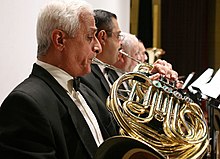   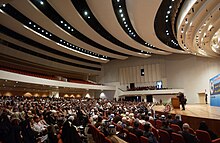  Baghdad has always played a significant role in the broader Arab cultural sphere, contributing several significant writers, musicians and visual artists. Famous Arab poets and singers such as Nizar Qabbani, Umm Kulthum, Fairuz, Salah Al-Hamdani, Ilham al-Madfai and others have performed for the city. The dialect of Arabic spoken in Baghdad today differs from that of other large urban centers in Iraq, having features more characteristic of nomadic Arabic dialects (Versteegh, The Arabic Language). It is possible that this was caused by the repopulating of the city with rural residents after the multiple sackings of the late Middle Ages. For poetry written about Baghdad, see Reuven Snir (ed.), Baghdad: The City in Verse (Harvard, 2013).[213] Baghdad joined the UNESCO Creative Cities Network as a City of Literature in December 2015.[214] Some of the important cultural institutions in the city include the National Theater, which was looted during the 2003 invasion of Iraq, but efforts are underway to restore the theater.[215] The live theater industry received a boost during the 1990s, when UN sanctions limited the import of foreign films. As many as 30 movie theaters were reported to have been converted to live stages, producing a wide range of comedies and dramatic productions.[216] Institutions offering cultural education in Baghdad include The Music and Ballet School of Baghdad and the Institute of Fine Arts Baghdad. The Iraqi National Symphony Orchestra is a government funded symphony orchestra in Baghdad. The INSO plays primarily classical European music, as well as original compositions based on Iraqi and Arab instruments and music. Mandaeans had cultural club in Al-Zawraa, where poetry evenings and cultural seminars were held, attended by poets, writers, artists, officials, and dignitaries of the communities.[217] There is also a social cultural center of Mandaeans at al-Qadisiyyah.[217] Baghdad is also home to a number of museums which housed artifacts and relics of ancient civilization; many of these were stolen, and the museums looted, during the widespread chaos immediately after United States forces entered the city. During occupation of Iraq, AFN Iraq ("Freedom Radio") broadcast news and entertainment within Baghdad, among other locations. There is also a private radio station called "Dijlah" (named after the Arabic word for the Tigris River) that was created in 2004 as Iraq's first independent talk radio station. Radio Dijlah offices, in the Jamia neighborhood of Baghdad, have been attacked on several occasions.[218] SportBaghdad is home to some of the most successful football (soccer) teams in Iraq, the biggest being Al-Shorta (Police), Al-Quwa Al-Jawiya (Air Force), Al-Zawraa, and Al-Talaba (Students). The largest stadium in Baghdad is Al-Shaab Stadium, which was opened in 1966. In recent years, the capital has seen the building of several football stadiums which are meant be opened in near future. The city has also had a strong tradition of horse racing ever since World War I, known to Baghdadis simply as 'Races'. There are reports of pressures by the Islamists to stop this tradition due to the associated gambling.[219]
Twin towns – sister cities
See also
NotesReferences
Further readingArticles
Books
External linksWikimedia Commons has media related to بغداد. Wikivoyage has a travel guide for Baghdad. Look up Baghdad in Wiktionary, the free dictionary.
|
|||||||||||||||||||||||||||||||||||||||||||||||||||||||||||||||||||||||||||||||||||||||||||||||||||||||||||||||||||||||||||||||||||||||||||||||||||||||||||||||||||||||||||||||||||||||||||||||||||||||||||||||||||||||||||||||||||||||||||||||||||||||||||||||||||||||||||||||

